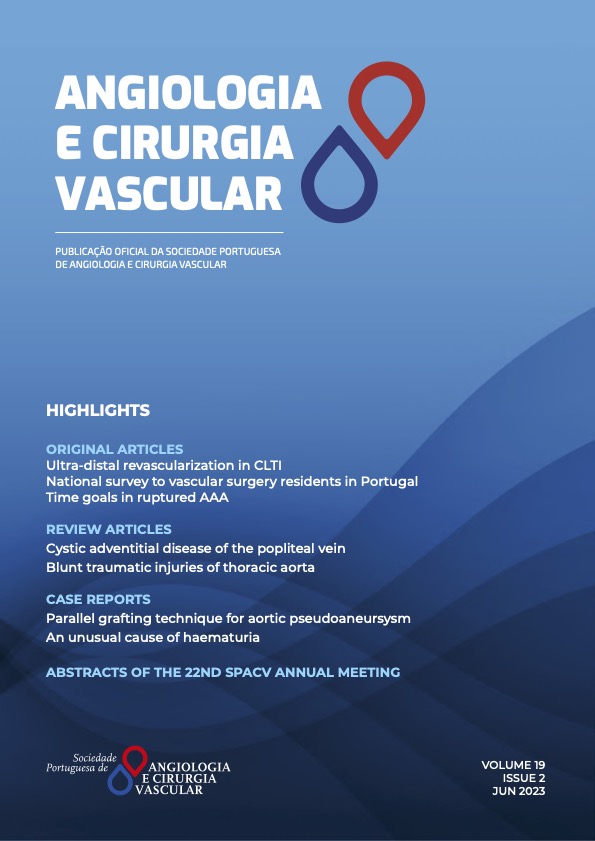Ultra-distal revascularization in chronic limb threatening ischaemia: results are never out of fashion
DOI:
https://doi.org/10.48750/acv.485Keywords:
Diabetic vascular complications, Diabetes mellitus, Chronic limb-threatening ischemia, Vascular surgical procedures, Distal and ultradistal bypassAbstract
INTRODUCTION: The progression of diabetes mellitus to a global epidemic resulted in an increased prevalence of tibioperoneal disease in chronic limb threatening ischemia (CLTI). Distal disease still poses an enormous challenge to vascular surgeons. Crural angioplasty was formerly restricted to patients with short stenotic lesions or to high-risk patients for bypass surgery. Nevertheless, endovascular treatment has been used preferentially over bypass surgery in most centres.
The aim of this study is to analyse the results of open ultra-distal revascularization in a single-centre with a limb preservation program for CLTI.
METHODS: The present study consists in a single-centre retrospective analysis of all patients with CLTI submitted to below the ankle bypass. The end points were limb-based patency (LBP), primary patency (PP) and secondary patency (SP) rates, freedom from CLTI, freedom from new CLTI, freedom from major index limb amputation, amputation free-survival, and overall survival. Patients were categorized in subgroups based on age (above or below 75 years), dialysis status, wound and infection grade (0 and 1 vs 2 and 3 in WIfI classification). Statistical analysis was carried out using Stata 12.1 (StataCorp®, Lakeway Drive, College Station, Texas, USA). Time-to-event end points were presented with Kaplan–Meier estimates, censored at major amputation, death, or last follow-up, and compared with the log rank test.
RESULTS: A total of 134 limbs in 122 patients with CLTI (83% male, median age of 68 years) were submitted to below the ankle bypasses. The median follow-up was 33.7 months. LBP, PP and SP were, respectively, 78%, 78% and 92% at 1 year, 73%, 73% and 88% at 2 years, and 62%, 62% and 79% at 4 years. At 1 year, 83% of the limbs were free from CLTI. Of these patients, 89% and 74% remained free from new CLTI at 2 and 4 years, respectively. Eighty-two percent of the patients were free from major index limb amputation at 4 years. Thirty-day mortality was 1.6% (2 patients) and 1-year and 2-year survival was 90% and 81%, respectively. Age, dialysis status and wound/infection grade (WIfI classification) did not influence patency rates.
CONCLUSION: Below the ankle bypass is safe and has excellent clinical outcomes. The present study emphasizes the value of open surgery in a challenging territory, with high rates of patency, limb salvage, freedom from CLTI and from new CLTI. These results were not affected by patient status or clinical severity factors.
Downloads
References
Norgren L, Hiatt WR, Dormandy JA, Nehler MR, Harris KA, Fowkes FGR. Inter-Society Consensus for the Management of Peripheral Arterial Disease (TASC II). European Journal of Vascular and Endovascular Surgery. 2007;33:S1–75.
Conte MS, Bradbury AW, Kolh P, White J v., Dick F, Fitridge R, et al. Global vascular guidelines on the management of chronic limb-threatening ischemia. J Vasc Surg. 2019;69:3S-125S.e40.
Mills JL. Update and validation of the Society for Vascular Surgery wound, ischemia, and foot infection threatened limb classification system. Semin Vasc Surg [Internet]. 2014;27:16–22.
Pomposelli FB, Kansal N, Hamdan AD, Belfield A, Sheahan M, Campbell DR, et al. A decade of experience with dorsalis pedis artery bypass: Analysis of outcome in more than 1000 cases. J Vasc Surg. 2003;37:307–15.
Spillerova K, Biancari F, Leppäniemi A, Albäck A, Söderström M, Venermo M. Differential Impact of Bypass Surgery and Angioplasty on Angiosome-Targeted Infrapopliteal Revascularization. European Journal of Vascular and Endovascular Surgery. 2015;49:412–9.
Romiti M, Albers M, Brochado-Neto FC, Durazzo AES, Pereira CAB, de Luccia N. Meta-analysis of infrapopliteal angioplasty for chronic critical limb ischemia. J Vasc Surg. 2008;47:975-81.
Menard MT, Farber A, Assmann SF, Choudhry NK, Conte MS, Creager MA, et al. Design and Rationale of the Best Endovascular Versus Best Surgical Therapy for Patients With Critical Limb Ischemia (BEST‐CLI) Trial. J Am Heart Assoc. 2016;6:5.
Popplewell MA, Davies H, Jarrett H, Bate G, Grant M, Patel S, et al. Bypass versus angio plasty in severe ischaemia of the leg - 2 (BASIL-2) trial: study protocol for a randomised controlled trial. Trials. 2016;17:11









